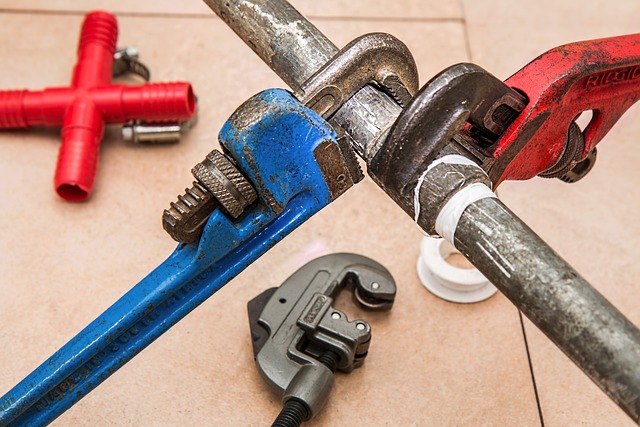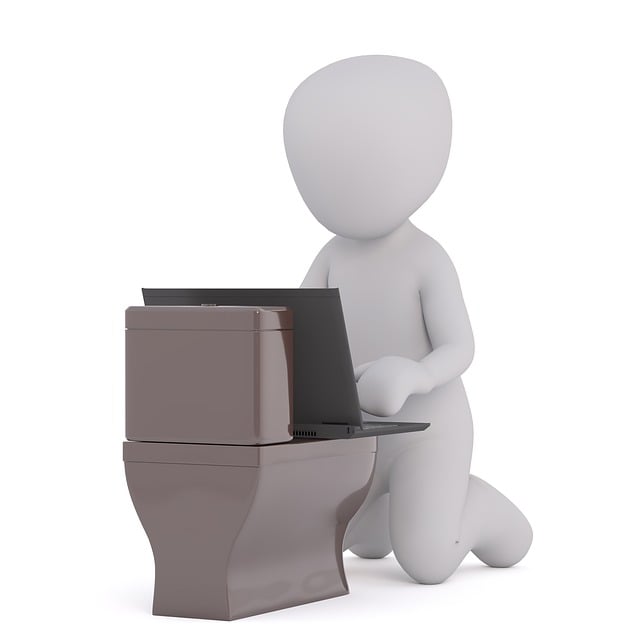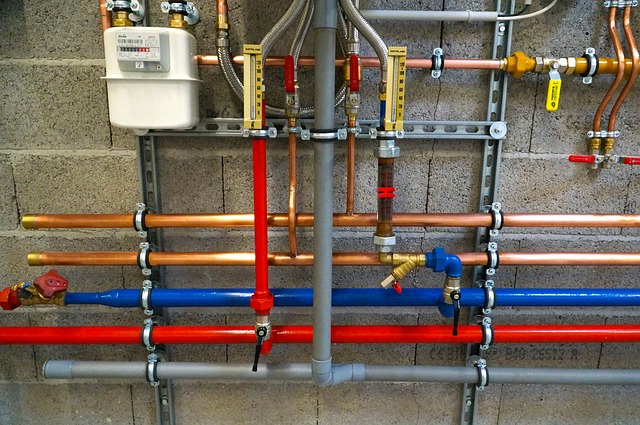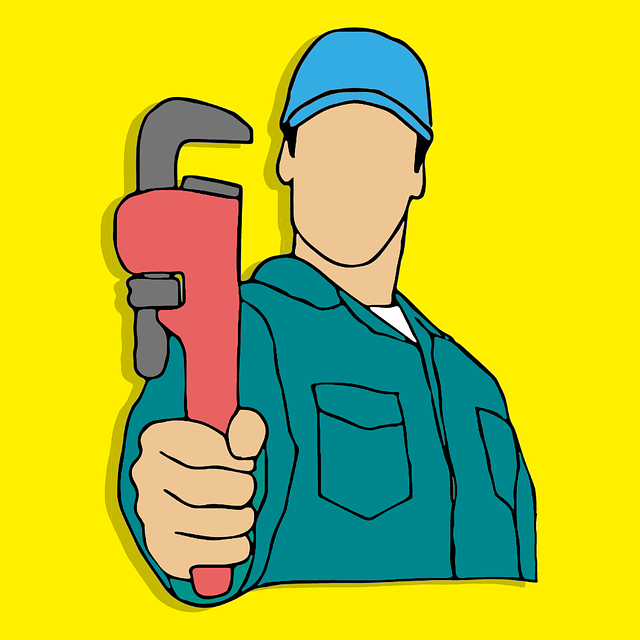Plumbers employ a sophisticated array of non-invasive and advanced technologies for detecting and locating water leaks with precision. These include visual inspections to identify obvious signs of leakage, acoustic devices that listen for unusual water flow sounds within walls, infrared cameras for thermal imaging to detect moisture behind surfaces, and moisture meters to measure concealed moisture levels. Electronic leak detectors are also used extensively, leveraging sensor technology to pinpoint leaks accurately without causing damage. Tracer gases like sulfur hexafluoride are introduced into piping systems to identify leaks with precision, while sonic leak detection equipment uses sound waves to locate disruptions within pipes. These methods enable plumbers to diagnose and repair leaks efficiently, minimizing property disruption and preventing water damage, thereby upholding property integrity and promoting environmental conservation. The integration of these techniques has significantly advanced the field of plumbing, allowing professionals to offer high-quality service with greater accuracy and less intrusion.
When it comes to safeguarding your home or business from the silent threat of water leaks, the expertise of plumbers is invaluable. This article delves into the various methodologies and technologies employed by these professionals to detect leaks with precision. From the initial visual inspections and tactile assessments by seasoned plumbers to the cutting-edge application of thermal imaging and acoustic tools, we explore how each technique contributes to leak detection. We’ll also examine electronic leak detectors that have revolutionized the industry, offering a non-invasive approach through tracer gases and sonic equipment to accurately pinpoint leaks. Understanding the tools at their disposal, as well as the science behind these techniques, is crucial for property owners to make informed decisions when it comes to maintaining water integrity and preventing costly damage.
- Understanding Water Leak Detection: The Plumber's Toolkit
- Visual Inspections and Physical Assessments by Skilled Plumbers
- Advanced Technology in Leak Detection: Thermal Imaging and Acoustic Tools
- Electronic Leak Detectors: A Game-Changer for Professional Plumbers
- Non-Invasive Techniques: How Plumbers Use Tracer Gases and Sonic Equipment to Pinpoint Leaks
Understanding Water Leak Detection: The Plumber's Toolkit

Plumbers employ a variety of advanced techniques and tools to detect water leaks efficiently and accurately. The detection process often begins with a visual inspection where plumbers look for signs such as wet spots, warped flooring, or lower water pressure on certain pipes. This step is crucial for pinpointing the general area of concern. Following the initial assessment, plumbers may utilize acoustic devices to listen for the sound of running or leaking water within walls and underground. These tools can differentiate between normal and abnormal water flow noises, guiding the plumber to the precise location of the leak.
In addition to auditory methods, plumbers also rely on technological equipment like infrared cameras and moisture meters to detect leaks non-invasively. Infrared cameras can capture thermal images that highlight temperature differences, which may indicate a leak due to cooler spots where water has seeped. Moisture meters measure the moisture content within materials, helping to confirm the presence of a leak behind walls, under floors, or beneath foundations. These devices are invaluable for their ability to isolate leaks without causing damage to property. By combining these traditional and modern methods, plumbers can effectively diagnose and address water leaks, ensuring that residential and commercial properties remain dry and secure from potential water damage.
Visual Inspections and Physical Assessments by Skilled Plumbers

Plumbers employ a variety of techniques to detect water leaks, with visual inspections and physical assessments being among the most fundamental. During a visual inspection, plumbers carefully examine pipes, fixtures, and joints for signs of wear or moisture that may indicate a leak. They look for discoloration, drips, or standing water, which can signal underlying issues. This process often involves checking under sinks, behind toilets, and in areas where leaks are commonly found. Skilled plumbers use their experience to identify subtle cues that may escape the average eye, ensuring a thorough investigation of potential leak points.
Furthermore, physical assessments by trained professionals are crucial for both confirming visual suspicions and locating hidden leaks. Plumbers may utilize specialized tools such as acoustic leak detectors to listen for the sound of flowing or rushing water within the pipes, which can be a telltale sign of a leak. Infrared cameras are another tool that plumbers use to detect moisture behind walls or underneath surfaces, revealing leaks that would otherwise remain invisible. These methods, combined with the plumber’s expertise, allow for effective leak detection and minimization of water waste and potential damage to property.
Advanced Technology in Leak Detection: Thermal Imaging and Acoustic Tools

Plumbers employ sophisticated technology to detect water leaks, ensuring efficient resolution of issues and minimizing potential damage. Among these advanced tools are thermal imaging cameras and acoustic leak detection devices. Thermal imaging allows plumbers to visualize temperature differences within a structure, which can pinpoint the presence of moisture underlying a surface that may indicate a leak. By capturing the infrared radiation emitted by surfaces, these cameras can detect subtle variations caused by leaking water, even through walls or beneath flooring. This method is particularly useful for identifying hidden leaks in insulated areas where other detection methods might fall short.
In parallel with thermal imaging, acoustic leak detection tools are indispensable in the plumber’s arsenal. These devices can listen for the high-frequency sounds emitted by escaping water, which are inaudible to the human ear. The acoustic technology can differentiate between the sound of a leak and other types of noise within the plumbing system. When combined with ground microphones or hydrophones, these tools can trace the path of the sound waves back to the exact location of the leak, even through complex piping networks. This non-invasive technique not only saves time but also reduces the need for destructive testing, making it a preferred choice for both residential and commercial settings. With these high-tech solutions, plumbers can precisely locate leaks, effectively repair them, and prevent unnecessary water waste.
Electronic Leak Detectors: A Game-Changer for Professional Plumbers

Plumbers have long been tasked with the responsibility of locating and addressing water leaks, a task that has evolved significantly with technological advancements. One such game-changing innovation in this field is the electronic leak detector. These devices have become indispensable tools for professional plumbers, revolutionizing the way leaks are detected. Electronic leak detectors work by utilizing advanced sensor technology to identify even the smallest of moisture presence. They can pinpoint leaks with high precision, often without the need for destructive testing. This capability saves time and resources, allowing plumbers to quickly diagnose issues and provide efficient solutions to their clients.
The electronic leak detector operates on the principle of detecting changes in ambient air humidity or ground moisture levels. These instruments are sensitive enough to differentiate between normal condensation and actual leaks, which is crucial for accurate detection. They are also capable of distinguishing between different types of leaks, whether it’s a slow drip from a faulty valve or a more substantial leak in a pipe beneath the floor. Plumbers equipped with these devices can thus offer more targeted repairs, reduce water waste, and prevent potential property damage caused by undetected water leaks. The integration of electronic leak detectors has not only streamlined the plumbing service process but also enhanced the overall efficiency and effectiveness of leak detection and repair.
Non-Invasive Techniques: How Plumbers Use Tracer Gases and Sonic Equipment to Pinpoint Leaks

Plumbers employ a variety of sophisticated, non-invasive techniques to detect water leaks within a plumbing system, minimizing disruption to property owners. Among these methods, the use of tracer gases stands out as particularly effective. By injecting harmless, odorless gases such as sulfur hexafluoride into the piping network, plumbers can trace the path of the gas with a detector. This approach allows for precise pinpointing of leak locations without the need for extensive excavation or destruction of property. The sensitivity of these tracer gas detectors is remarkable, often identifying leaks as small as a drip, ensuring that even the most elusive leaks are found.
In addition to tracer gases, sonic equipment has become an indispensable tool in the plumber’s arsenal for non-destructive leak detection. Acoustic leak detectors use sound waves to listen to water flow and pressure changes within pipes. High-frequency sound waves travel through the pipes and are reflected back to the detector when they encounter a change in the pipe’s condition, such as a crack or a leak. By analyzing these sonic echoes, plumbers can accurately determine the exact location of leaks. This method is particularly useful for pinpointing subsurface leaks beneath concrete slabs or in other hard-to-reach areas, making it a valuable skill for professional plumbers to master and apply effectively. Through the strategic use of tracer gases and sonic equipment, plumbers can efficiently detect leaks without causing unnecessary damage, saving property owners time and money while ensuring that leaks are resolved swiftly and accurately.
In conclusion, plumbers employ a blend of traditional expertise and advanced technology to effectively detect water leaks. From visual inspections and physical assessments by skilled professionals to the sophisticated application of thermal imaging and acoustic tools, the trade’s toolkit is well-equipped for this task. Electronic leak detectors have revolutionized the field, offering precise and efficient solutions. Moreover, non-invasive techniques involving tracer gases and sonic equipment ensure that property integrity is maintained while accurately pinpointing leaks. Plumbers’ proficiency in these methods underscores their commitment to resolving water issues with both care and competence.
